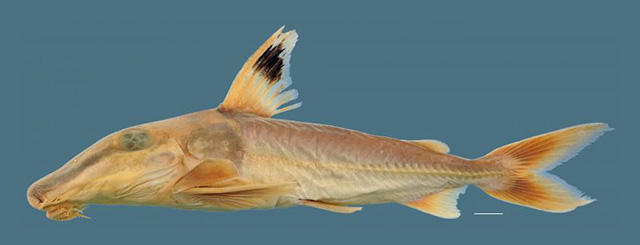|
Dorsal spines (total): 2-2; Dorsal soft rays (total): 6-6; Anal soft rays: 12-15. This species differs from other species of Hassar by its relatively narrow interorbital and long snout, interorbital width 32.2-44.7% distance from snout tip to anterior naris (vs. 45.0-89.4%). It is most similar to H. orestis, but it can be further separated from that species by having gas bladder with few, weakly developed peripheral diverticula restricted to anterolateral shoulder and posterolateral face of anterior chamber, and sometimes anterolateral face of posterior chamber (vs. well developed diverticula with multiple branches and grouped into fascicles encircling horizontal periphery of gas bladder in H. orestis), and posterior face of gas bladder smooth, broadly to narrowly rounded (vs. posterior chambers expanded posteriorly into medially conjoined ternimal diverticula, effecting acutely subtriangular, cone-shaped posterior face). This species also differs from H. affinis and H. gabiru by its snout, distance snout tip to anterior naris 9.5-12% SL (vs. 6.9-9.7% SL), interorbital width 3.4-4.8% SL and 9.8-14.7% HL (5.9-8.0% SL and 17.3-24.3% HL), and caudal peduncle depth 4.8-5.6% SL (vs. 6.6-8.0% SL). It is diagnosed from all congeners except H. orestis by the distal half of soft dorsal fin consisting of distinct dark subtriangular blotch not extending to distal margin, pale margin complete, its width approaching that of blotch (vs. distal half of soft dorsal dfn dusky to margin in H. affinis; or with dark blotch leaving narrow pale distal margin, width less than half that of dark blotch, in H. gabiru, H. wilderi and sometimes H. orestis) (Ref. 93284). |

